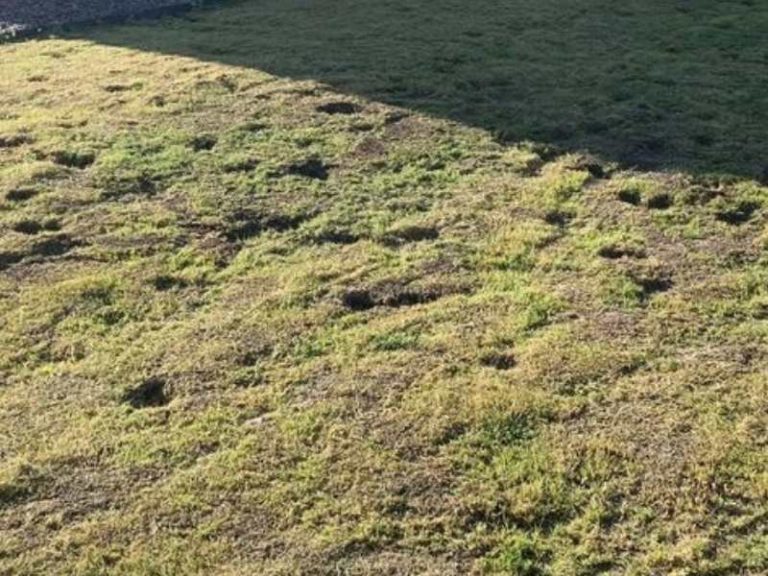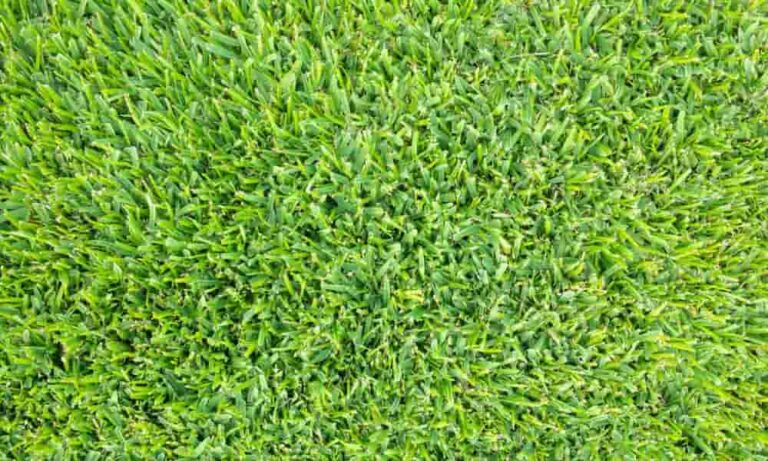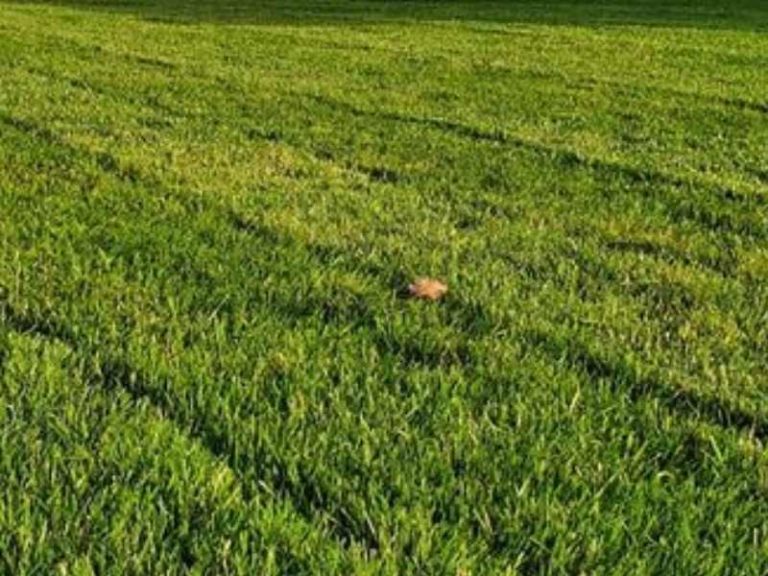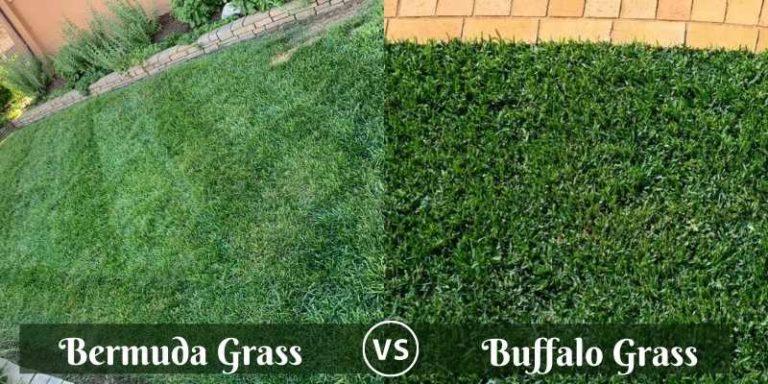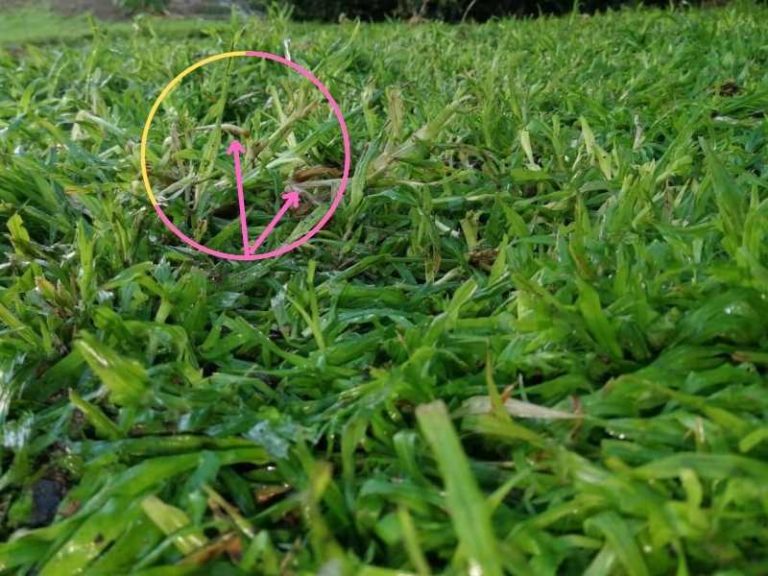Buffalo Grass – Identification, Care, Planting, Cost & More
Buffalo grass is a warm-season perennial grass native to the Great Plains region of North America. It is highly drought tolerant and has better cold hardiness than other warm-season turfgrasses. You can identify it through the fine-textured, blue-green curled leaves that form an attractive, uniform lush lawn. Buffalo grass spreads through above-ground stolons, not rhizomes, and grows to a height of 8-10 inches.
To establish a buffalo grass lawn, planting options include sod, plugs, sprigs, or seeds. Late spring through early summer is the ideal planting time. Maintenance needs are relatively low, but supplemental irrigation, occasional mowing at 3-4 inches, and weed control to keep the lawn healthy. Herbicides may be required to manage summer broadleaf/grassy and winter weeds.
To know whether buffalo grass is the right turfgrass, read this blog to learn its identification features, how to establish it, and the proper care and maintenance practices to keep it in good shape.
Table of Contents
What is Buffalo Grass?
Buffalo grass is a warm-season, perennial turfgrass native to the Great Plains of North America. It boasts exceptional heat and drought tolerance and relatively better cold-hardiness than most warm-season turfgrasses. Meanwhile, its fine-textured, curly leaves with a blue-green hue form a uniform and attractive turf.
Here is the taxonomical classification of buffalo grass:
- Kingdom: Plantae
- Division: Magnoliophyta
- Class: Liliopsida (Commelinidae)
- Order: Cyperales
- Family: Poaceae
- Genus: Bouteloua
- Species: Bouteloua dactyloides
How to Identify Buffalo Grass (with pictures)
You can identify buffalo grass through the unique features of its leaves and flowers, as well as its growth habit.
Leaves
Buffalo grass leaf blades curl over, giving the turf a short appearance. The leaf has rolled vernation, lacks auricles, and the ligule is a fringe of hairs. The tip of the blade is pointed.
Flowers
Buffalo grass has male and female plants; you’ll rarely find male and female flowers on the same plant. The male flower features a 4-6 inch high seed stalk with 2-3 spikes. On the other hand, the female flower only appears on the upper leaves and is characterized by a short spike with spikelets.
Growth Habit
Buffalo grass grows and spreads via above-ground runners called stolons and doesn’t have rhizomes. It’s a low-growing grass that typically reaches 8-10 inches high. The stolon grow laterally for several feet, with 2-3 inch internodes. Buffalo grassroots at the nodes (which are smooth) before producing shoots in the form of tufts of leaves.
Tip: Buffalo grass is a vascular, flowering plant in the monocot lineage. The species name dactyloides (refers to the finger-like appearance) of the buffalo grass inflorescences.
| Buffalo Grass Characteristic | Description |
| Scientific Name | Bouteloua dactyloides |
| Common name | Buffalo grass |
| Family | Poaceae |
| Growth Habit | Low-growing perennial grass |
| Leaves | Blue-green color, Fine-bladed, curly leaves |
| Height | 8-10 inches |
| Root System | Shallow and fibrous |
| Growth | It has no rhizomes, spreads by stolon’s |
| Tolerance | Poor shade tolerant, excellent drought tolerant, good cold tolerant, low-moderate traffic tolerant |
| Establishment | Seed, sod, plugs, sprigs |
| Care | Mow 3-4 inches high, fertilize 1-2lbs per year, irrigate low (1-2 inches) per month, moderate-high weed susceptibility |
| Uses | Low-maintenance lawns, xeriscaping |
| Dormancy Period | Winter |
| Regional Adaptation | Great Plains, Southwest |
| Origin | North America |
Read more: what does buffalo grass look like?
How to Establish Buffalo Grass Lawn
Depending on the cultivar, you can establish buffalo grass lawns from seed or vegetative. Vegetative propagation methods include sodding and plugging. Avoid planting this turfgrass in shaded areas, as it has poor shade tolerance.
Sod
Planting Buffalo grass sod produces an instant lawn without too much hassle. The best time of the year to plant buffalo grass sod is in the months of April, May, and June. Ensure the soil is well-prepared before planting by removing debris, leveling, and firming with a roller.
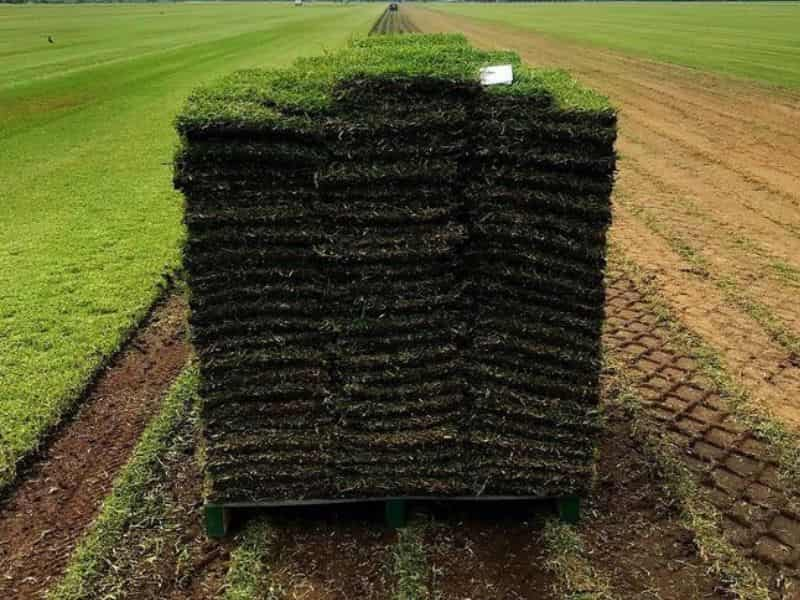
Newly sodded Buffalo grass may turn brown immediately after installation, even if adequately watered. This is normal, and the turf should regain its green color in 7-14 days after the sod pieces have established their roots in the soil.
Ensure proper irrigation during the root formation period; that is, make sure the root zone beneath the sod stays moist but not wet.
Seed
Buffalo grass seeds are difficult to harvest since they’re usually located deep inside the turfgrass canopy. Thus, the seeds of this turfgrass are more expensive than those of comparable warm-season grasses. This method is also energy intensive and is best reserved for instances where sodding or plugging aren’t preferable.
The best time of the year to plant buffalo grass seed is in late spring. During this season, soil temperatures are favorable, and natural precipitation is usually available. This perennial grass requires the soil to warm to 55 degrees Fahrenheit to germinate, usually in late spring.
Use a seed drill to plant Buffalo grass seeds in rows. Using treated seeds significantly boosts the germination rate; untreated seeds have a reduced chance of germination. Water the area immediately after planting to stimulate germination and maintain a regular irrigation schedule until most seeds have germinated.
Note: Buffalo seeds are usually treated to break dormancy by chilling them at 5-10 degrees for 6-8 weeks.
If enough moisture is available, Buffalo grass seed will germinate in 7-10 days. The ideal seeding rate is 10-20 pounds per acre if you want to complete cover within one growing season. However, if you’re willing to wait, plant between 0.5 and 6 pounds per 1000 square feet of lawn area.
Plugs and sprigs
When establishing a Buffalo lawn from sod plugs, select female plants, as they don’t produce tall, unsightly seed stalks like their male counterparts. Also, before planting, prepare the soil by removing rocks and debris. If the soil is loose and uneven, go over the lawn with a roller to make it firm and level. You can also apply a Pendimethalin-based pre-emergent herbicide at this stage to prevent weed invasion.
Plant the plugs in holes dug 6-24 inches apart, with closer spacing resulting in quicker complete coverage. The best time to plant Buffalo sod plugs is from spring after the last frost up until fall, six weeks before the first expected frost date.
Also, ensure you keep the plug roots moist when planting, as they die out quickly whenever they dry out.
You can apply a starter fertilizer right after planting and again after 7 weeks. Irrigate the lawn after planting the seeds and applying starter fertilizer. Continue irrigating 3 times daily for 7-10 days. Light, frequent irrigation is recommended.
Note: the plugs will turn brown after planting, but this is temporary and shouldn’t be cause for concern. They usually spring back to life once they’re well-rooted in the soil.
Care and Maintenance
Buffalo grass is a native grass and, thus, one of the low-maintenance grasses and doesn’t need to be watered or fertilized as much as non-native grasses. Still, the right maintenance practices help keep the turf healthy.
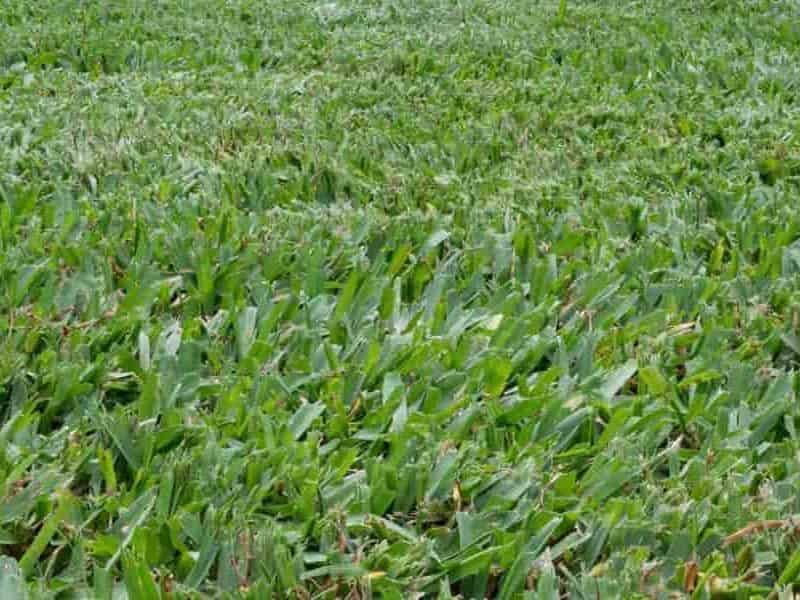
Watering
A buffalo grass lawn can survive without supplemental irrigation once it’s established. However, it’s likely to go dormant if not watered during periods of drought in the summer. When this happens, the lawn will look unsightly, and weeds will likely invade.
Once the grass germinates, stop watering daily and adopt a deep, infrequent watering schedule (one inch every 2-4 weeks) to maintain the health and quality of the turf. This is usually from late May to early July. Then, from mid-summer, continue providing the lawn with at least 1-2 inches of water every 2-4 weeks to prevent summer dormancy.
Buffalo grass shouldn’t be watered earlier in the season (March-April) as this promotes weed invasion. Also, the above irrigation rates denote the total amount of moisture that should be provided. Thus, if there’s rainfall in your area, only apply supplemental irrigation if necessary.
Fertilization
A newly established Buffalo grass lawn can be fertilized once or twice after 21 days when the seedlings appear. The second application should be done six weeks after the first. Follow the manufacturer’s recommendations for seeding rates and avoid using weed-and-feed products.
Meanwhile, an established Buffalo grass lawn only needs 1-2 pounds of nitrogen fertilizer annually to maintain its health and quality. Preferably, apply a slow-release nitrogen fertilizer (3-1-2 NPK ratio) in the summer. Ideally, Split applications are recommended once in early June and early September.
Tips for fertilization
- Avoid using a quick-release fertilizer, as you’ll likely overfeed the grass. Over-fertilizing buffalo grass encourages weed invasion, especially when soil contains too much moisture.
- Meanwhile, if your lawn soil has a high pH and the Buffalo grass shows signs of leaf chlorosis, use an iron-rich fertilizer to treat this problem.
Mowing
Buffalo grass has low mowing requirements and will suffer if mowed regularly. Still, buffalo grass lawns should occasionally be mowed to suppress weed growth and encourage the stolons to spread into bare areas.
Mow as necessary, at 3-4 inches in height, throughout the growing season. Don’t remove more than 1/3 of the leaf blade surface area when mowing. Additionally, if you mow higher, you’ll need to mow more frequently to maintain the shape and health of the turf.
Stop mowing the lawn between October and November once the grass stops growing.
Read More on how to mow buffalo grass.
Weed control
Generally, buffalo grass doesn’t do well at outcompeting weeds due to its thin growth habit. It’s vulnerable to weed takeover, especially in high-rainfall areas. Weeds will easily establish and spread in thin or bare spots in the lawn. In the summer, apply a quinclorac-based post-emergent herbicide to effectively get rid of broadleaf and grassy weeds growing on buffalo grass lawns.
Then, when the buffalo grass is dormant in November, apply a non-selective post-emergent herbicide to eliminate winter weeds. A herbicide containing glyphosate as the primary active ingredient is recommended.
Avoid applying herbicides containing 2, 4-D to buffalo grass when temperatures exceed 85 degrees Fahrenheit, as the grass is sensitive to this herbicide and will suffer damage.
Buffalo Grass Varieties
There are several varieties of buffalo grass, and they can generally be classified into two: those that can be propagated from seed since they have both male and female flowers on the same plant and those that can only be propagated vegetatively.
- Buffalo grass cultivars with commercially available seeds include Bison, Cody, Plains, Bowie, Texoka, Topgun, and Sharp’s Improved.
- Buffalo grass cultivars that can only be propagated vegetatively include Density, Legacy, Prairie, Prestige, Turffalo, Eco, UC Verde, and ‘609’.
Pests
The most common pests on Buffalo grass are chinch bugs and buffalo grass webworms.
- Chinch bugs, especially western chinch bugs- overwinter in the turf and emerge from early spring, feeding on the sap from the grass plant tissues. As they feed, they inject toxic saliva into the plant tissue, which inhibits the optimal uptake of water and nutrients. The result is usually yellow-brown patches on the turf and, in severe cases, thinning and dead grass.
Apply bifenthrin or carbaryl-based insecticides to control western chinch bugs on buffalo grass effectively.
- Buffalo grass webworms typically invade buffalo grass turfs from mid-summer, causing considerable dieback. It’s difficult to control these insects using insecticides, and follow-up treatments are usually necessary if you wish to get rid of the damage as soon as possible.
However, a better approach is to do nothing at all since buffalo grass webworms are usually approaching the end of their feeding cycle by the time you notice severe damage on the turf. You can then repair damaged spots on the turf by reseeding or sprigging.
Note: Other insects that may occasionally invade buffalo grass include the leaf hopper, mound-building prairie ant, and June beetle. All these pests can be controlled with common insecticides.
Diseases
Buffalo grass is susceptible to various diseases, including false smut, leaf blotch, leaf rust, and witches’ broom.
- False smut– this fungal disease is prevalent in buffalo grass grown in high rainfall areas between May and June. It causes tiny black/brown spots on the grass leaf blades; the best way to prevent it is by using disease-resistant buffalo grass cultivars.
- Leaf blotch– this fungal disease typically infects buffalo grass in June and causes black blotches on the leaves. There are no known controls, but resistant varieties are available.
- Leaf rust– this is also a fungal disease that causes pre-mature drying of buffalo grass leaves. There are no known remedies, but hybrid varieties are known to be more resistant.
- Witches’ broom – this disease is caused by Eriophyses mites, common in newly established Buffalo grass lawns. It causes stunted growth/dwarfism. Some strains of buffalo grass are resistant to this disease.
Other Problems with Buffalo Grass
Buffalo grass responds poorly to excessive traffic and overgrazing, and the turf will deteriorate when exposed to these factors.
- Buffalo grass performs poorly in acidic soils and prefers a soil pH of 6.5-8.0.
- Buffalo grass has moderate salt tolerance but will struggle in highly saline soils.
- Poor shade tolerance and summer dormancy without irrigation.
Here are the pros and cons of Buffalo grass lawns.
Uses of buffalo grass
- Buffalo grass is primarily used as lawn turfgrass due to its superior drought tolerance and adaptability to a wide range of soil types. This native turfgrass also has a decent tolerance for moderate foot traffic and cold conditions.
- Commercially, it’s used to produce ready-to-lay sod for lawns, golf courses, and sports fields.
- Buffalo grass works well as a cover crop, as it chokes out weeds by outcompeting them for moisture and nutrients. It’s also commonly used in public spaces and roadsides due to its relatively better wear tolerance compared to other warm-season grasses. See how buffalo grass compares with Bermuda grass.
The life cycle of Buffalo grass
Buffalo grass exhibits a summer dormancy period in hot weather and a winter dormancy period in cold weather. The grass grows actively and spreads in the cooler spring and fall seasons. Its ability to go dormant allows buffalo grass to survive droughts and extreme temperatures.
| Stage | Activities |
| Establishment Stage | Buffalo grass typically begins from seeds or plugs. Adequate watering and proper soil preparation are crucial during this phase. At this stage, the main activities are geared toward strong root development and initial growth. |
| Growth Stage | At this stage, grass rapidly develops and spreads, characterized by the expansion of the grass canopy, with the blades growing taller and denser. Buffalo grass spreads via above-ground stolons during the active growing seasons of spring and fall. Stolons root at nodes to form new plants. The main activities include; Regular watering, fertilization, and mowing contribute to a healthy and vibrant lawn. Warm temperatures and sunlight make the grass thrive |
| Dormancy stage | Buffalo grass typically begins from seeds or plugs. Adequate watering and proper soil preparation are crucial during this phase. The main activities are geared toward strong root development and initial growth at this stage. |
| Revival stage | Once the conditions get conducive, the buffalo grass reawakens and starts to regrow and regain its green color. Activities include adequate watering, fertilizer application, and overseeding to aid the grass revival process. |
Note: This cycle repeats itself, with the buffalo grass transitioning between growth, dormancy, and revival stages based on environmental factors and seasonality, although the area zone also plays an important role in this.
What are the downsides of buffalo grass?
Buffalo grass has poor shade tolerance, weed invasion, overwatering, overfertilization, leaf chlorosis, summer dormancy without irrigation, and mowing stress if too frequent. Overwatering and overfertilizing buffalo grass can promote weed growth, thinning the turf. Buffalo grass dies in patches due to lawn fungus (brown patch) disease.
What are the pros and cons of buffalo grass lawns?
Buffalo grass demands minimal maintenance, providing an attractive option for those seeking an easily managed lawn. Its remarkable drought-resistant grass makes it a resilient choice in arid conditions, while its fine blades contribute to a soft and visually pleasing texture. The grass also demonstrates good shade tolerance, adapting well to varying sunlight levels.
On the flip side, buffalo grass exhibits slow growth, potentially delaying the establishment of a lush lawn. Its limited color variety may not appeal to those seeking a vibrant green hue. Additionally, susceptibility to invasive weeds and cold sensitivity in frigid climates. Read more Pros and cons of buffalo grass.
References
Kansas State College of Agriculture and Applied Science: Buffalo Grass


